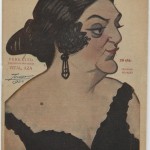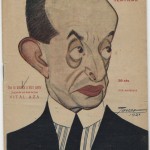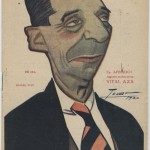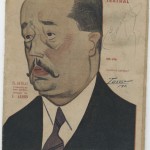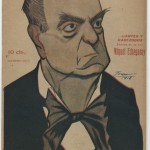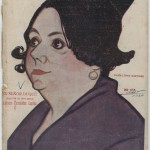Everybody loves cartoons. They proliferate in modern newspapers and on the Internet. From Peanuts to Doonesbury, cartoons provide commentary and amusement for the reader. The sueltas collection at the Harry Ransom Center, currently being cataloged under a grant from the Council on Library and Information Resources, also features its own first-rate cartoons. Created by Manuel Tovar, a famous twentieth-century caricaturist, these unique “monos,” as caricatures are known in Spanish, present unusual and interesting depictions of actors and actresses.
Born in Granada in 1875, Tovar illustrated postcards and painted fans and parasols as a young man. When he moved to Madrid, he fulfilled his life-long dream of working as a caricaturist and cartoonist, publishing his first cartoon in 1901 in the magazine Nuevo Mundo. Subsequently, he created cartoons in many well-known magazines and newspapers such as Blanco y Negro, La Correspondencia, El Gráfico, El Liberal, El Heraldo de Madrid, and El Cuento Semanal, whose cover he illustrated regularly for three years. For 15 years, Tovar created a popular daily cartoon for La Voz. He passed away suddenly in 1935, just after completing his daily entry.
Known for his sagacious wit and unique style, Tovar is widely considered one of the greatest caricaturists of his age. The sueltas collection contains a number of items from the “Novela Teatral” series, produced under the direction of José de Urquía from 1916 to 1925. This series is typical of the caricature work done by Tovar, which often depicted real figures in Madrid society. The “Novela Teatral” caricatures portrayed actors and actresses, but Tovar was perhaps most famous for his drawings of political figures and writers. In an interview, he once lamented that political cartoons had caused him a great deal of trouble, as many of his subjects found their representations less than flattering. His artistic style did not change in response to the criticism. He had one confrontation regarding a caricature of a government minister, Juan de la Cierva, who was illustrated wearing unattractive plaid pants. Embarrassed by the portrayal, the minister invited Tovar to inspect his wardrobe and note the lack of plaid pants. Another incident had Tovar hiding in the salon at a theater from an umbrella-brandishing disgruntled authoress who wished to punish the artist for his unflattering caricature of her.
Tovar is credited with having a profound and perfect knowledge of contemporary life in Madrid, and these delightful illustrations provide a fascinating look into the atmosphere of Madrid during the early twentieth century. The sueltas collection continues to provide us with opportunities for remarkable and thought-provoking study.
Please click on the thumbnails below to view full-size images.

